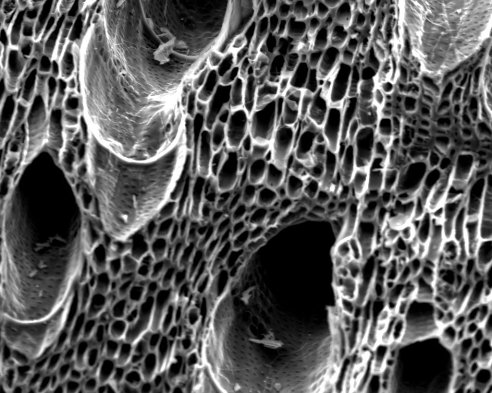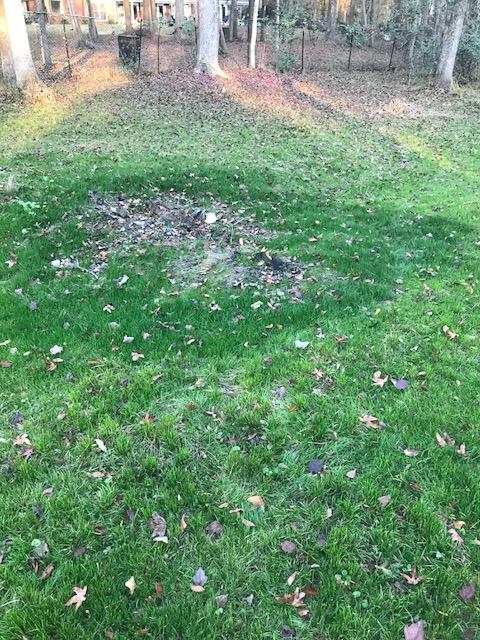Carbon is the most important element in the soil.
That’s an easy, broad statement to make.

But why is it true?
Take a burn pile for instance

Notice the grass damaged by the fire, but in the area around it, the grass is significantly greener than the rest of the lawn. This is the result of carbon (and potash, but mostly carbon). And that’s why carbon is the most important element in the soil.
To understand its importance, it’s important to understand its role in soil development.
First, there’s the carbon cycle. Basically, the carbon cycle is the soil’s natural ability to produce its own carbon through production and death of plant roots. As roots die, and cycle, they deposit back into the soil as organic matter to continuously break down by microbial activity to carbon. Microbes then house is in the deposited carbon to reproduce and then feed on the next root death deposit. This cycle continues and continues, and as long as vegetation lives on the surface, the roots will continue to improve its soil condition (through the carbon cycle.)
End of story… right? Well, not so fast.
As turf managers, our product is our result. And results take time to achieve. Typically, we have one calendar year to “make or break” a property. Establishing a mono-culture of turf is the first step. Uniformity is aesthetically pleasing. Producing a dark green color also adds to the aesthetics. Both of these can be done in a one year time frame. However, the current approach in the industry to get to this point is to use synthetic nutrients (mostly nitrogen) to drive green, fast growing grass.
So if we can achieve a dark green lawn with nitrogen only, why worry about carbon?
Remember we talked about how we had one year to “make or break” a property? In one year, we can supplement synthetically to make a property. But if we continue to do that year over year, by year three, we begin to break the property. So then the question becomes – how does THAT happen?
So by pushing growth with nitrogen, we stimulate significant top growth without doing much to develop root growth. Especially if we’re supplementing with high rates of N. What happens is lack of root development contributes to a lack of carbon cycling back into the soil. Fewer roots develop, fewer die, less carbon is deposited back into the soil, fewer microbes populate, and the health of the soil begins to decline. Remember, carbon is the most important element in the soil…
The turfgrass at this point will become so dependent on synthetic nutrients because the soil will not develop enough health to be able to store nutrients, or break down OM to produce its own nutrients.
In theory, but cutting down our nitrogen rates, the turfgrass could then maintain its root development at an adequate rate. And then through the course of years of carbon cycling, the soil health will improve and the turf will really thrive.
Good stuff!
Except… for those years of carbon build up to take place, the lawn will not have the same aesthetic value as another company that’s using higher N rates.
It’s a lose/lose situation. We run high N rates, our lawns look good short term, suffer long term. We run low in rates, our lawns suffer short term, look good long term.
So what do we do?
If we begin supplementing carbon with each fertilizer application, we can build soil OM levels, microbe populations, which in turn initiate a faster carbon cycle. At that point, the answer is easy – supplement carbon. In case you forgot, carbon is the most important element in the soil.
But how do we supplement carbon?
There are a few ways we can do this. Top dressing with compost is one way – but it’s labor intensive and expensive. The second way would be utilizing an organic fertilizer like a bio-solid which comes from human waste. This can be applied through a spreader and is relatively cheap.
So the easy answer is to apply bio-solids or compost.
Well, not so fast.
With top dressing, according to the USDA study, it takes 10 pounds of organic material to decompose into one pound of organic matter. That is a LOT of material to break down into very little material.
According to the study from VA Tech, 10-15 lbs of organic matter per thousand square feet need to be applied through the course of the year to reduce your nitrogen inputs. In terms of compost, that’s applying 100-150 pounds of compost per thousand square feet. Not only is that unbelievably expensive, it’s incredibly difficult to spread. The logistics of even moving that much material is difficult. Incorporating that much material into the soil is a daunting task.
Using that same study, it can be more easily done with bio-solids and manure. 10-15lbs per thousand square feet per year is still expensive, very expensive, but it’s easier to source the material and spread the material. The problem we run into with bio-solids and manure is it’s expense often eliminates the budget to supply additional nutrients. And while bio-solids and manures do supply nutrients, they’re in limited quantities and the timing of their release is dependent on soil temperatures. According to Texas A&M, there are sweet spots of microbial activity in relation to soil temperature. Between 60-85 degrees, we see the greatest growth in microbial activity. It’s in that temperature phase, we get the release from bio-solids and manures. Outside of that, we don’t. And that leaves our program open to be surpassed by competitors.
Let’s wrap this up with our approach to soil fertility.
Recapping what we’ve discussed:
- Carbon is important.
- Synthetics are required to keep results on part or better than competitors
- Topdressing is expensive
- Bio-solids and manures are less expensive, but inconsistent.
At Outdoor Designs, we utilize bridge products. We use carbon delivery sources from many different actives with EVERY fertilizer application we make. We utilize bio-solids, manures, BIO-CHAR, and humic acids to deliver the appropriate amounts of carbon to create self-sustaining soils. Combining carbon sources with synthetics we get the initial consistent, predictable feed we come to know and expect as well as the soil building properties that come with carbon based fertility. We know that carbon is the most important element in the soil.
Contact us today to find out how carbon can improve your property.